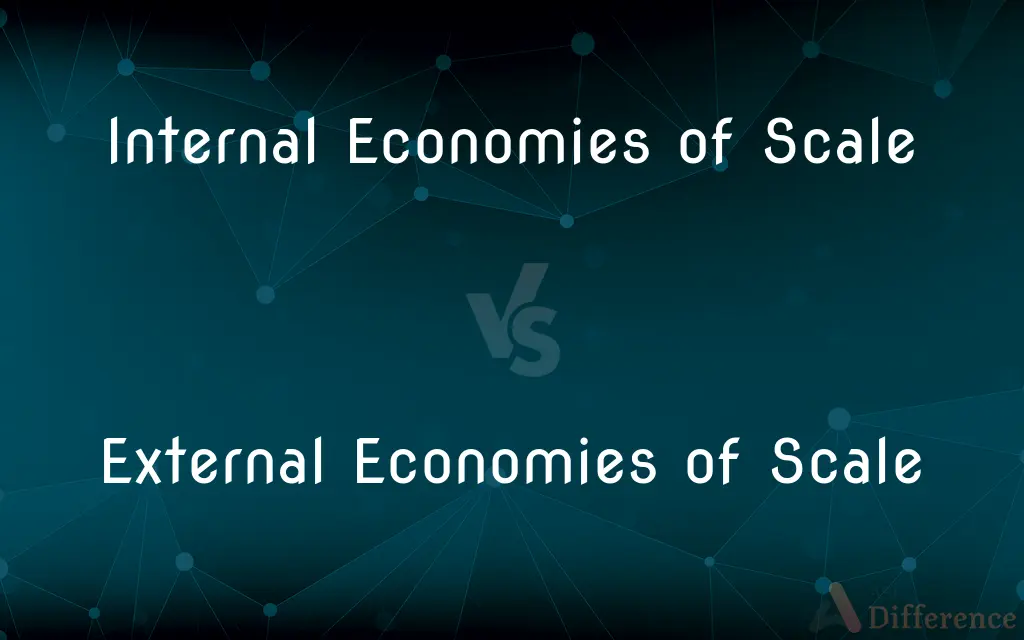Internal Economies of Scale vs. External Economies of Scale — What's the Difference?
Edited by Tayyaba Rehman — By Fiza Rafique — Published on December 10, 2023
Internal Economies of Scale refer to cost-saving benefits a company gains as it expands its own operations. External Economies of Scale are cost reductions resulting from factors outside the company, like industry growth.

Difference Between Internal Economies of Scale and External Economies of Scale
Table of Contents
ADVERTISEMENT
Key Differences
Internal Economies of Scale revolve around the benefits a company derives when it expands its own production or operations. As companies grow in size, they often become more efficient, leading to reduced average costs of production. This could be due to better management systems, more efficient machinery, or bulk purchasing advantages.
External Economies of Scale, on the other hand, don't stem directly from the growth of an individual firm. Instead, they come into play when an industry as a whole expands. The benefits may arise from factors like the growth of supplier networks, improvements in infrastructure, or the availability of a skilled labor pool specific to that industry.
While Internal Economies of Scale can be controlled and harnessed by the firm itself, External Economies of Scale are often beyond the firm's control. This is because they are reliant on external industry factors.
That said, both Internal Economies of Scale and External Economies of Scale aim for the same outcome: reduced production costs. But while the former is driven by internal company growth, the latter depends on the growth of the industry or region.
Comparison Chart
Source of Benefit
Arise from the growth of the company itself.
Stem from the growth of the industry or external factors.
ADVERTISEMENT
Control
Within the firm's control.
Beyond a single firm's control.
Examples
Bulk purchasing, specialized machinery.
Infrastructure improvements, skilled labor availability.
Dependency
Dependent on company size and internal efficiencies.
Dependent on industry size and external factors.
Direct Influence
Companies can directly influence through expansion.
Influenced by collective actions of industry participants.
Compare with Definitions
Internal Economies of Scale
Internal Economies of Scale denote savings linked to a company's own growth.
Their bulk purchasing agreements brought about tremendous Internal Economies of Scale.
External Economies of Scale
External Economies of Scale arise from factors external to a firm, benefiting the industry.
Improved infrastructure provided External Economies of Scale to all manufacturers in the region.
Internal Economies of Scale
Internal Economies of Scale are cost reductions arising from expanded company operations.
As the company grew, it achieved Internal Economies of Scale, leading to lower production costs.
External Economies of Scale
External Economies of Scale occur when industry growth reduces a firm's costs.
The development of local suppliers led to External Economies of Scale for many firms in the area.
Internal Economies of Scale
Internal Economies of Scale arise when company growth leads to cost efficiencies.
By centralizing their operations, they experienced notable Internal Economies of Scale.
External Economies of Scale
External Economies of Scale stem from external industry factors benefiting multiple firms.
The establishment of a research park brought External Economies of Scale to the adjacent businesses.
Internal Economies of Scale
Internal Economies of Scale result from a firm's expansion and operational efficiencies.
The merger resulted in substantial Internal Economies of Scale due to shared resources.
External Economies of Scale
External Economies of Scale refer to savings linked to the growth of an industry or region.
The creation of a specialized training program introduced External Economies of Scale in the sector.
Internal Economies of Scale
Internal Economies of Scale refer to savings from increased company production levels.
Their new machinery led to significant Internal Economies of Scale.
External Economies of Scale
External Economies of Scale result from benefits outside a specific company.
As the tech industry flourished, many startups experienced External Economies of Scale.
Common Curiosities
Are External Economies of Scale within a single firm's control?
No, they depend on factors external to the firm, like industry growth.
Can a firm control Internal Economies of Scale?
Yes, they arise from the firm's own growth and operational decisions.
How do External Economies of Scale differ?
They are cost reductions resulting from external industry factors or growth.
Give an example of Internal Economies of Scale.
A company buying raw materials in bulk at discounted prices due to increased production.
Why are External Economies of Scale important to industries?
They can reduce costs for all firms in the industry due to external factors.
Can External Economies of Scale be temporary?
Yes, they can change if the industry contracts or if external benefits diminish.
What are Internal Economies of Scale?
Cost-saving benefits a company achieves as it expands its own operations.
Provide an example of External Economies of Scale.
Improved infrastructure in a region benefiting all businesses operating there.
What's a disadvantage of relying on External Economies of Scale?
They're not within a firm's direct control and can be influenced by broader industry changes.
What drives Internal Economies of Scale?
Factors like better management, efficient machinery, and bulk purchasing.
Can small companies benefit from External Economies of Scale?
Absolutely, as these benefits arise from industry or regional growth and can apply to all firms.
How do Internal Economies of Scale affect production costs?
They lead to reduced average costs as the company expands its operations.
Is it easier for large companies to achieve Internal Economies of Scale?
Generally, yes, as they can leverage their size for efficiencies and cost savings.
How do both Internal and External Economies of Scale impact competition?
They can lead to lower production costs, making firms more competitive in pricing.
Do External Economies of Scale depend on a single company's growth?
No, they depend on the growth or development of an entire industry or region.
Share Your Discovery

Previous Comparison
Celexa vs. Lexapro
Next Comparison
X-ray vs. UltrasoundAuthor Spotlight
Written by
Fiza RafiqueFiza Rafique is a skilled content writer at AskDifference.com, where she meticulously refines and enhances written pieces. Drawing from her vast editorial expertise, Fiza ensures clarity, accuracy, and precision in every article. Passionate about language, she continually seeks to elevate the quality of content for readers worldwide.
Edited by
Tayyaba RehmanTayyaba Rehman is a distinguished writer, currently serving as a primary contributor to askdifference.com. As a researcher in semantics and etymology, Tayyaba's passion for the complexity of languages and their distinctions has found a perfect home on the platform. Tayyaba delves into the intricacies of language, distinguishing between commonly confused words and phrases, thereby providing clarity for readers worldwide.
















































